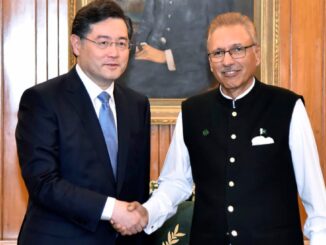
From NOT A LOT OF PEOPLE KNOW THAT
By Paul Homewood
h/t Paul Kolk
Matt McGrath blames the Pakistan floods on climate change (even though the scientists are not quite so sure!):
Global warming is likely to have played a role in the devastating floods that hit Pakistan, say scientists.
Researchers from the World Weather Attribution group say climate change may have increased the intensity of rainfall.
However there were many uncertainties in the results, so the team were unable to quantify the scale of the impact.
The scientists believe there’s roughly a 1% chance of such an event happening in any coming year. ..
But extreme rainfall events are hard to assess. Pakistan is located on the edge of the monsoon region where the rainfall pattern is extremely variable from year to year.
Further complications include the impact of large-scale weather events such as La Niña, which also played a role in the last major floods in Pakistan in 2010.
During the 60-day period of heaviest rainfall this summer scientists recorded an increase of about 75% over the Indus river basin, while the heaviest five-day period over the provinces of Sindh and Balochistan recorded a rise in rainfall of around 50%.
The researchers then used climate models to determine how likely these events would be in a world without warming.
Some of the models indicated that the increases in rainfall intensity could all be down to human-caused climate change – however there were considerable uncertainties in the results.
https://www.bbc.co.uk/news/science-environment-62915648
Perhaps McGrath and the “scientists” should have looked at the actual data, rather than playing with their computer models. According to the Pakistan Meteorological Department, most of the excess rain in August arrived on 18th/19th and 25th/26th. In fact 41% of the month’s rainfall fell on these four days:
http://www.pmd.gov.pk/cdpc/home.htm
The cause of this heavy rain was simple – two tropical storms, which had crossed from the Bay of Bengal – BOB06 and BOB 07. (In the Indian Ocean they are categorised as a “Depression” and “Deep Depression”. In Atlantic storm terminology, these would be named as a Tropical Depression and a Tropical Storm respectively).
http://www.pmd.gov.pk/cdpc/home.htm
Both storms followed identical routes west from Bengal, tracking over Rajahstan, before hitting the province of Sindh head on, the region worst affected by flooding:
Unusually, these storms did not dissipate after landfall, so were able to wreak havoc for days afterwards. Pakistan, needless to say, is not immune to tropical cyclones. Last year Cyclone Tauktae hit the country, but that was in May, rather than during the monsoon.
But for two storms to hit in the space of a week, at the same location, and during the wettest month of the year is an extremely rare combination of meteorological events.
Pakistan was already experiencing a wetter than normal monsoon, courtesy of La Nina, but those two storms pushed the rainfall into record territory, the wettest August since 1961.
There is, of course, no evidence that tropical cyclones are getting more frequent or intense in the Indian Ocean, so consequently there is also no evidence that last month’s rainfall had anything to do with climate change.
What is significant, though, is the chart of annual rainfall in Pakistan, published in the State of the Pakistan Climate 2021:
Pakistan annual rainfall
http://www.pmd.gov.pk/cdpc/home.htm
Annual rainfall was clearly much less during the 1960s and 70s, the direct result of global cooling. Those years of drought were a disaster for Pakistan, and the country welcomes the increase in rainfall since, just as they do across the border in India.
It is also significant that the 7-year moving average has barely changed since the 1980s, fluctuating up and down, but with no long term trend. If global warming was really bringing more extreme rainfall, we should expect to see evidence of this in the annual figures.
You will hear none of this from Matt McGrath, or the so-called scientists who write these fraudulent climate attribution studies, such as Friederike Otto:
https://www.bbc.co.uk/news/science-environment-62915648
So let’s recall what Roger Pielke Jr had to say about climate attribution:
Or as Obama’s Climate Scientist, Steve Koonin put it:
“Practitioners argue that event attribution studies are the best climate science can do in terms of connecting weather to changes in climate. But as a physical scientist, I’m appalled that such studies are given credence, much less media coverage. A hallmark of science is that conclusions get tested against observations. But that’s virtually impossible for weather attribution studies. Its like a spiritual adviser who claims he influence helped you win the lottery — after you’ve already won it.



